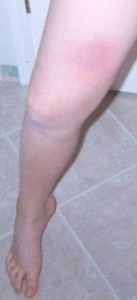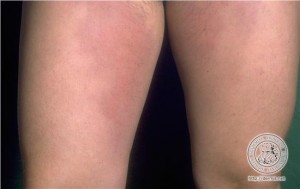Disturbed at the sight of red, bumpy rashes on your skin? You might be having a case of Panniculitis. Read on to know all about Panniculitis, its causes, symptoms and treatment.
Panniculitis Definition
Page Contents
What is Panniculitis? Medical researchers define Panniculitis as a condition that is characterized by the swelling of the subcutaneous fatty layer, particularly in the abdomen. Subcutaneous fat lies just below the epidermis or the outer layer of the skin. The condition gives rise to elevated red spots or nodules on the skin.
Panniculitis disease does not appear only in humans. It can also be found in other animals. You can see Panniculitis in dogs. Panniculitis in cats are not too uncommon either.
Panniculitis Classification
There are several types of Panniculitis. Know about some of the major Panniculitis types.
Lupus Panniculitis
This is a type of Panniculitis that is marked by subcutaneous fat inflammation, especially in the face. In this condition, the skin becomes thick, tender and often elevated. There may be a discoloration in the nodules. Panniculitis and lupus completely destroys fat cells and leaves hard deep nodules that may take months or even years to go away.
Septal Panniculitis
This is another kind of Panniculitis that has the Subcutaneous layer affecting the adipose tissue layer lying between dermis and fascia of the skin.
Cold Panniculitis
The skin may suffer Panniculitis from cold temperatures. When the skin is exposed to very cold temperatures, the adipose tissues get damaged. These lead to localized inflammation of the skin. This is particularly common in obese women and infants who are exposed to cold temperatures in winter months.
Mesenteric Panniculitis
Mesenteric Panniculitis is a rare disorder that arises from an unknown cause. It is marked by a chronic inflammation of the adipose tissue of the abdominal cavity. This arises due to malignant conditions like Systemic Lymphoma or Gastric Carcinoma. Systemic inflammatory conditions may also lead to this disease. People who have undergone recent abdominal surgery can also suffer from this disorder.
An ultrasound or CT scan is usually enough to diagnose this condition. In severe cases, it is treated with medicines like Azathioprine and Corticosteroids.
Panniculitis Symptoms
Some of the major symptoms of Panniculitis are :
Redness
The raised nodules on the skin commonly have a reddish appearance.
Oily Discharge
The skin spots may secrete an oily discharge from time to time.
Tenderness
The affected people may experience tenderness while touching the raised spots.
Weight Loss
There is also a visible loss of weight in sufferers. This usually happens if there is a systemic disease along with the condition. Systemic diseases are conditions that affect multiple organs and tissues or even the entire body as seen in Multiple Organ Dysfunction Syndrome.
Fatigue
Affected people can also suffer from fatigue or tiredness due to this condition.
Panniculitis Causes
Panniculitis can arise due to a number of factors. Some of the most common causes of Panniculitis are :
Skin Trauma
Trauma or injury of the skin is a common cause of Panniculitis. The skin may suffer injuries due to vigorous exercise or intravenous injections. In some cases, Panniculitis can also arise from skin trauma resulting from cryosurgery (surgery that is done by freezing a part of the skin).
Lymphoma
This is a malignant condition of the lymphatic tissue which can give rise to red spots over the skin. Lymphoma is supposed to give rise to Panniculitis along with other systemic conditions. Panniculitis Lymphoma is quite common in people with cancerous conditions.
Pancreatitis
Pancreatitis or Pancreatic Cancer is another notable cause of Panniculitis. The disease is marked by an inflammation of the pancreas. Pancreatic Panniculitis patients commonly experience abdominal pain. In Pancreatic Panniculitis abdomen pain is also accompanied with nausea and vomiting. Fortunately, Panniculitis pancreatitis is a rare form of Panniculitis.
Cold Temperatures
In a few cases of Panniculitis cold is also seen as a culprit. Extremely cold temperatures can give rise to raised red nodules symptomatic of Panniculitis.
Infection
In people suffering from Panniculitis infection is found to one of the major causes. This arises due to viruses or microbes like bacteria and fungi and parasites.
Alpha 1 Deficiency
A deficiency of the inhibitor Alpha 1 Antitrypsin can also bring on this disorder. Panniculitis is often a sign of Alpha 1 deficiency. Alpha 1 deficiency is a genetic condition that can lead to lung and liver disorders in adults. It also causes liver diseases in children. Alpha 1 deficiency is usually a very rare condition. Since 1972, there have been only 100 cases reported about Alpha 1 Panniculitis.
Panniculitis Treatment
The treatment of Panniculitis is usually carried out in different ways. If the doctor diagnoses you with Panniculitis, he would usually prescribe you anti-inflammatory medicines of a non-steroidal nature. Antibiotics like Dapsone and Doxycycline and steroids may also be used depending on the symptoms you are having.
Rest and elevation are two other remedies that the body needs o recover from Panniculitis. A patient with Panniculitis needs to take a break and give rest to the body. The affected part should be elevated above other regions for a quicker recovery.
People suffering from Panniculitis due to Alpha 1 deficiency are treated with Augmentation therapy. Augmentation therapy is found to be very useful in treating Panniculitis patients.
There is however, no sure way of treating Panniculitis. It is being speculated that newer researches on therapies for Alpha 1 deficiency will yield some result and open up ways to cure Panniculitis.
Panniculitis Pictures
Want to know how Panniculitis looks like? Check out these Panniculitis photos and get an idea about the appearance of the condition.

Picture 1 – Panniculitis
Source – pedrheumonlinejournal

Picture 2 – Panniculitis
Source – dermis
Panniculitis is not a serious, life-threatening condition. But in rare cases involving Alpha 1 deficiency, it can give rise to grave complications like heart or lung disorders. So if you spot symptoms similar to Panniculitis in yourself or any of your near ones, it is better to seek medical treatment as early as possible. Early treatment will help you prevent any serious health situation in future and enjoy life in the best of your health.
References:
http://en.wikipedia.org/wiki/Panniculitis
http://www.ehow.com/facts_6293193_panniculitis-vasculitis.html
http://www.healthscout.com/ency/68/175/main.html
http://www.wrongdiagnosis.com/p/panniculitis/intro.htm
http://www.alpha-1foundation.org/alphas/?c=12-Alpha-1-Panniculitis
http://cure4lupus.org/store/index.php?main_page=page&id=156&chapter=1
http://www.ncbi.nlm.nih.gov/pubmed/19360363
http://emedicine.medscape.com/article/1082003-overview
http://en.wikipedia.org/wiki/Cold_panniculitis

No Responses